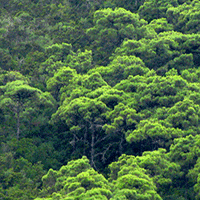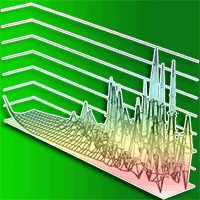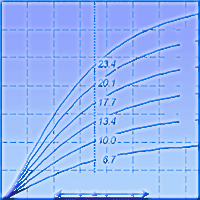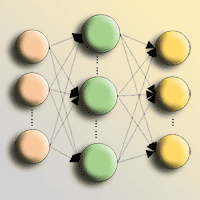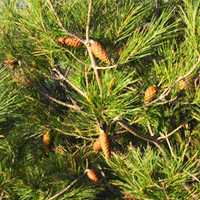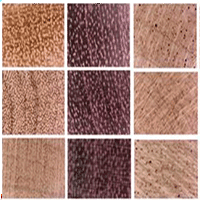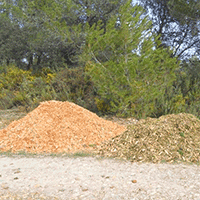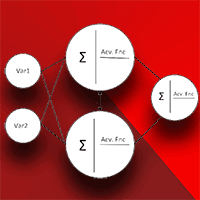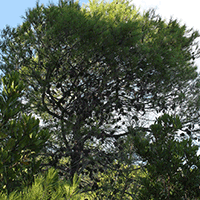Estimating forest transpiration is of great importance for Adaptive Forest Management (AFM) in the scope of climate change prediction. AFM in the Mediterranean region usually generates a mosaic of different canopy covers within the same forest. Several models and methods are available to estimate forest transpiration, but most require a homogeneous forest cover, or an individual calibration/validation process for each cover stand. Hence, a model capable of reproducing accurately the transpiration of the whole canopy-cover mosaic is necessary. In this paper, the use of Artificial Neural Network (ANN) is proposed as a flexible tool for estimating forest transpiration using the forest cover as an input variable. To that end, sap flow, soil water content and other environmental variables were experimentally collected under five Aleppo pine stands of different canopy covers for two years. These sets of inputs were then used for the ANN training. Stand transpiration was accurately estimated using climate data, soil water content and forest cover through the ANN approach (correlation coefficient R = 0.95; Nash-Sutcliffe coefficient E = 0.90; root-mean-square error RMSE = 0.078 mm day-1). Finally, the input value for soil water content (when not available) was computed using the process-based model Gotilwa+. Then, this computed soil water content was used as input in the proposed ANN. This combination predicted the forest transpiration with values of R = 0.90, E = 0.63, and RMSE = 0.068 mm day-1. Artificial Neural Network proved to be a useful and flexible tool to predict the transpiration dynamics of an Aleppo pine stand regardless of the heterogeneity of the forest cover produced by adaptive forest management.
Keywords
, , ,
Citation
Fernandes TJG, Campo ADD, García-Bartual R, González-Sanchis M (2015). Coupling daily transpiration modelling with forest management in a semiarid pine plantation. iForest 9: 38-48. - doi: 10.3832/ifor1290-008
Academic Editor
Francesco Ripullone
Paper history
Received: Mar 17, 2014
Accepted: Mar 25, 2015
First online: Aug 06, 2015
Publication Date: Feb 21, 2016
Publication Time: 4.47 months
© SISEF - The Italian Society of Silviculture and Forest Ecology 2015
Open Access
This article is distributed under the terms of the Creative Commons Attribution-Non Commercial 4.0 International (https://creativecommons.org/licenses/by-nc/4.0/), which permits unrestricted use, distribution, and reproduction in any medium, provided you give appropriate credit to the original author(s) and the source, provide a link to the Creative Commons license, and indicate if changes were made.

Breakdown by View Type
(Waiting for server response...)
Article Usage
Total Article Views: 52202
(from publication date up to now)
Breakdown by View Type
HTML Page Views: 43618
Abstract Page Views: 3313
PDF Downloads: 3882
Citation/Reference Downloads: 26
XML Downloads: 1363
Web Metrics
Days since publication: 3779
Overall contacts: 52202
Avg. contacts per week: 96.70
Article Citations
Article citations are based on data periodically collected from the Clarivate Web of Science web site
(last update: Mar 2025)
Total number of cites (since 2016): 12
Average cites per year: 1.20
Publication Metrics
by Dimensions ©
Articles citing this article
List of the papers citing this article based on CrossRef Cited-by.
(1)
Adeloye AJ, Rustum R, Kariyama ID (2012)Neural computing modelling of the reference crop evapotranspiration. Environmental Modelling and Software 29: 61-73.
CrossRef |
Gscholar
(2)
Allen RG, Pereira LS, Raes D, Smith M (1998)Crop evapotranspiration. Guide lines for computing crop evapotranspiration. FAO Irrigation and Drainage Paper 56, United Nations of Food and Agriculture Organization, Rome, Italy, pp. 15.
Online |
Gscholar
(3)
Asbjornsen H, Goldsmith GR, Alvarado-Barrientos MS, Rebel K, Osch FPV, Rietkerk M, Chen J, Gotsch S, Tobón C, Geissert DR, Gómez-Tagle A, Vache K, Dawson TE (2011)Ecohydrological advances and applications in plant-water relations research: a review. Journal of Plant Ecology 4: 3-22.
CrossRef |
Gscholar
(4)
Barret D, Hatton T, Ash J, Ball M (1995)Evaluation of the heat pulse velocity technique for measurement of sap flow in rainforest and eucalyptus forest species of south-eastern Australia. Plant, Cell and Environmental 18: 463-469.
CrossRef |
Gscholar
(5)
Bennett ND, Croke BFW, Guariso G, Guillaume JHA, Hamilton SH, Jakeman AJ, Marsili-Libelli S, Newham LTH, Norton JP, Perrin C, Pierce SA, Robson B, Seppelt R, Voinov AA, Fath BD, Andreassian V (2013)Characterising performance of environmental models. Environmental Modelling and Software 40: 1-20.
CrossRef |
Gscholar
(6)
Bergmeir C, Benitez JM (2012)Neural networks in R using the Stuttgart Neural Network Simulator: RSNNS. Journal of Statistical Software 46: 1-26.
Online |
Gscholar
(7)
Binoti MLMS, Binoti DHB, Leite HG (2013a)Aplicação de redes neurais artificiais para estimação da altura de povoamentos equianeos de eucalipto [Application of artificial neural networks to estimate the height of even-aged stands of eucalyptus]. Revista Árvore 37: 639-645. [in Portuguese]
CrossRef |
Gscholar
(8)
Binoti DHB, Binoti MLMS, Leite HG, Silva AALA, Albuquerque AC (2013b)Modelagem da distribuição de diametros utilizando autômatos celulares e redes neurais artificiais [An approach to diameter distribution modeling using cellular automata and artificial neural network]. Cerne 19: 677-685. [in Portuguese]
CrossRef |
Gscholar
(9)
Birot Y, Gracia C (2011)The hydrologic cycle at a glance: blue and green water. In: “Water for forests and people in the Mediterranean region: a challenging balance. What Science Can Tell Us” (Birot Y, Gracia C, Palahi M eds). EFI, Joensuu, Finland, pp. 17-21.
Gscholar
(10)
Bishop CM (1995)Neural networks for pattern recognition. Clarendon Press, Oxford, UK, pp. 482.
Online |
Gscholar
(11)
Borghetti M, Cinnirella S, Magnani F, Saracino A (1998)Impact of long-term drought on xylem embolism and growth in
Pinus halepensis Mill. Trees - Structure and Function 12: 187-195.
CrossRef |
Gscholar
(12)
Buckley TN, Turnbull TL, Pfautsch S, Gharun M, Adams MA (2012)Differences in water use between mature and post-fire regrowth stands of subalpine
Eucalyptus delegatensis R. Bker. Forest Ecology and Management 270: 1-10.
CrossRef |
Gscholar
(13)
Burgess SO, Adams MA, Turner NC, Beverly CR, Ong CK, Khan AH, Bleby TM (2001)An improved heat pulse method to measure low and reverse rates of sap flow in woody plants. Tree Physiology 21: 589-598.
CrossRef |
Gscholar
(14)
Burke LI, Ignizio JP (1992)Neural networks and operations research: an overview. Computers and Operations Research 19: 179-189.
CrossRef |
Gscholar
(15)
Castro RVO, Soares CPB, Leite HG, Souza AL, Nogueira GS, Martins FB (2013)Individual growth model for Eucalyptus stands in Brazil using artificial neural network. ISRN Forestry, Article ID 196832, pp. 1-12.
CrossRef |
Gscholar
(16)
Chirino E, Bellot J, Sánchez JR (2011)Daily sap flow rate as an indicator of drought avoidance mechanisms in five Mediterranean perennial species in semi-arid southeastern Spain. Trees - Structure and Function 25: 593-606.
CrossRef |
Gscholar
(17)
Cohen Y, Cohen S, Cantuarias-Aviles T, Schiller G (2008)Variations in the radial gradient of sap velocity in trunks of forest and fruit trees. Plant and Soil 305: 49-59.
CrossRef |
Gscholar
(18)
Davie T (2008)Fundamentals of hydrology (2nd edn). Routledge Fundamentals of Physical Geography, London, UK, pp. 200.
Online |
Gscholar
(19)
Dekker SC, Bouten W, Verstraten JM (2000)Modelling forest transpiration from different perspectives. Hydrological Process 14: 251-260.
CrossRef |
Gscholar
(20)
Del Campo AD, Aguilella A, Lidón A, Segura G (2008)Influencia del tipo y dosis de hydrogel en las propriedades hidrofísicas de tres suelos forestales de distinta textura [Effects of dosage and type of hydrogel in the hydro-physical properties of three different textured soils]. Cuadernos de la Sociedad Española de Ciencias Forestales 25: 137-143. [in Spanish]
Gscholar
(21)
Del Campo AD, Fernandes TJG, Molina AJ (2014)Hydrology-oriented (adaptive) silviculture in a semiarid pine plantation: how much can be modified the water cycle through forest management? European Journal of Forest Research 133: 879-894.
CrossRef |
Gscholar
(22)
Delzon S, Sartore M, Granier A, Loustau D (2004)Radial profiles of sap flow with increasing tree size in maritime pine. Tree Physiology 24: 1285-1293.
CrossRef |
Gscholar
(23)
Diamantopoulou M, Milios E (2010)Modelling total volume of dominant pine trees in reforestations via multivariate analysis and artificial neural network models. Biosystems Engineering 105: 306-315.
CrossRef |
Gscholar
(24)
Falkenmark M (2003)Freshwater as shared between society and ecosystems: from divided approaches to integrated challenges. Philosophical transactions of the Royal Society of London Series B Biological sciences 358: 2037-2049.
Online |
Gscholar
(25)
Farrington P, Bartle GA, Watson GD, Salama RB (1994)Long-term transpiration in two eucalypt species in a native woodland estimated by the heat-pulse technique. Australian Journal of Ecology 19: 17-25.
CrossRef |
Gscholar
(26)
Fitzgerald J, Jacobsen JB, Blennow K, Thorsen BJ, Lindner M (2013)Climate change in European forests: how to adapt. Policy Brief no 9, European Forest Institute, Joensuu, Finland, pp. 16.
Online |
Gscholar
(27)
Garcia-Santos G (2007)An ecohydrological and soils study in a montane cloud forest in the National Park of Garajonay, La Gomera. PhD thesis, Vrije Universiteit, Amsterdam, The Netherlands, pp. 188.
Online |
Gscholar
(28)
Garcia-Santos G (2011)Transpiration in a sub-tropical ridge-top cloud forest. Journal of Hydrology 462: 42-52.
Online |
Gscholar
(29)
Gorgens EB, Leite HG, Santos HN, Gleriani JM (2009)Estimação do volume de árvores utilizando redes neurais artificiais [Estimate of tree volume using artificial neural nets]. Revista Árvore 33: 1141-1147. [in Portuguese]
CrossRef |
Gscholar
(30)
Gracia CA, Tello E, Sabaté S, Bellot J (1999)GOTILWA: an integrated model of water dynamics and forest growth. In: “Ecological Studies 137: Ecology of Mediterranean Evergreen Oak Forest” (Rodà F, Retana J, Gracia C, Bellot J eds). Springer Berlin, Heidelberg, Germany, pp. 163-179.
CrossRef |
Gscholar
(31)
Haykin S (1994)Neural networks, a comprehensive foundation. Macmillan College Publishing Company, New York, USA, pp. 842.
Gscholar
(32)
Hornik K, Stinchcombe M, White H (1989)Multilayer feedforward networks are universal approximators. Neural Networks 2: 359-366.
CrossRef |
Gscholar
(33)
Huo Z, Feng S, Kang S, Dai X (2012)Artificial neural network models for reference evapotranspiration in an arid area of northwest China. Journal of Arid Environments 82: 81-90.
CrossRef |
Gscholar
(34)
Igel C, Hüsken M (2003)Empirical evaluation of the improved Rprop learning algorithms. Neurocomputing 50: 105-123.
CrossRef |
Gscholar
(35)
IPCC (2007)Summary for policymakers. In: “Climate Change 2007: Impacts, Adaptation and Vulnerability. Contribution of Working Group II to the Fourth Assessment Report of the Intergovernmental Panel on Climate Change” (Parry ML, Canziani OF, Palutikof JP, Van der Linden CE, Hanson CE eds) Cambridge University Press, Cambridge, UK, pp. 7-22.
Gscholar
(36)
Jasechko S, Sharp ZD, Gibson JJ, Birks SJ, Yi Y, Fawcett PJ (2013)Terrestrial water fluxes dominated by transpiration. Nature 496: 347-350.
CrossRef |
Gscholar
(37)
Jing-Hua X, Rusli X, Kumta AS (2010)Feedforward neural network trained by BFGS algorithm for modeling plasma etching of silicon carbide. IEEE Transactions on Plasma Science 38: 142-148.
CrossRef |
Gscholar
(38)
Kramer K (2001)Process-based models for scaling up to tree and stand level. In: “Long-Terms effects of climate change on carbon budgets of forests in Europe. ” (Kramer K, Mohren GMJ eds). Report no. 194, Alterra, Green World Research, Wageningen, The Netherlands, pp. 61-78.
Gscholar
(39)
Kramer K, Leinonen I, Bartelink HH, Berbigier P, Borghetti M, Bernhofer C, Cienciala E, Dolman AJ, Froer O, Gracia CA, Granier A, Grünwald T, Hari P, Jans W, Kellomäki S, Loustau D, Magnani F, Markkanen T, Matteucci G, Mohren GMJ, Moors E, Nissinen A, Peltola H, Sabaté S, Sanchez A, Sontag M, Valentini R, Vesala T (2002)Evaluation of six process-based forest growth models using eddy-covariance measurements of CO
2 and H
2O fluxes at six forest sites in Europe. Global Change Biology 8: 213-230.
CrossRef |
Gscholar
(40)
Kumar M, Raghuwanshi NS, Singh R, Wallender WW, Pruitt WO (2002)Estimating evapotranspiration using artificial neural network. Journal of Irrigation and Drainage Engineering 128: 224-233.
CrossRef |
Gscholar
(41)
Kumar M, Raghuwanshi NS, Singh R (2011)Artificial neural networks approach in evapotranspiration modeling: a review. Irrigation Science 29: 11-25.
CrossRef |
Gscholar
(42)
Lagergren F, Lindroth A (2002)Transpiration response to soil moisture in pine and spruce trees in Sweden. Agricultural and Forest Meteorology 112: 67-85.
CrossRef |
Gscholar
(43)
Lawrence DM, Thornton PE, Oleson KW, Bonan GB (2007)The partitioning of evapotranspiration into transpiration, soil evaporation, and canopy evaporation in a GCM: impacts on land-atmosphere interaction. Journal of Hydrometeorology 8: 862-880.
CrossRef |
Gscholar
(44)
Leite HG, Silva MLM, Binoti DHB, Fardin L, Takizawa FH (2011)Estimation of inside-bark diameter and heartwood diameter for
Tectona grandis Linn. trees using artificial neural networks. European Journal of Forest Research 130: 263-269.
CrossRef |
Gscholar
(45)
Li XY, Yang P, Ren S (2009)Study on transpiration model for fruit tree based on generalized regression neural network. In: Proceedings of the “International Conference of Engineering Computation”. Washington (DC, USA) 2-3 May 2009. IEEE Xplore, IEEE, NY, USA, pp. 269-272.
CrossRef |
Gscholar
(46)
Lindner M, Maroschek M, Netherer S, Kremer A, Barbati A, Garcia-Gonzalo J, Seidl R, Delzon S, Corona P, Kolström M, Lexer MJ, Marchetti M (2010)Climate change impacts, adaptive capacity, and vulnerability of European forest ecosystems. Forest Ecology and Management 259: 698-709.
CrossRef |
Gscholar
(47)
Liu X, Kang S, Li F (2009)Simulation of artificial neural network model for trunk sap flow of
Pyrus pyrifolia and its compartion with multiple-linear regression. Agricultural Water Management 96: 939-945.
CrossRef |
Gscholar
(48)
Mackay SL, Arain MA, Khomik M, Brodeur JJ, Shumacher J, Hartmann H, Peichl M (2012)The impact of induced drought on transpiration and growth in a temperate pine plantation forest. Hydrological Process 26: 1779-1791.
CrossRef |
Gscholar
(49)
Maier HR, Dandy GC (2000)Neural networks for the prediction and forecasting of water resources variables: a review of modelling issues and applications. Environmental Modelling and Software 15: 101-124.
CrossRef |
Gscholar
(50)
Meijun Y, Peiling Y, Shumei R, Yuanpei L, Tingwu X (2007)A backward propagation neural network for predicting daily transpiration of poplar. New Zealand Journal of Agricultural Research 50: 1277-1284.
CrossRef |
Gscholar
(51)
Molina AJ, Del Campo A (2012)The effects of experimental thinning on throughfall and stemflow: a contribution towards hydrology-oriented silviculture in Aleppo pine plantations. Forest Ecology and Management 269: 206-213.
CrossRef |
Gscholar
(52)
Morales P, Sykes M, Prentice C, Smith P, Smith B, Bugmanns H, Zierls B, Friedlingstein P, Viovy N, Sabaté S, Sánchez A, Pla E, Gracia CA, Sitch S, Arneth A, Ogee J (2005)Comparing and evaluating process-based ecosystem model predictions of carbon and water fluxes in major European forest biomes. Global Change Biology 11: 2211-2233.
CrossRef |
Gscholar
(53)
Nawi NM, Ransing MR, Ransing RS (2006)An improved learning algorithm based on the Broyden-Fletcher-Goldfarb-Shanno (BFGS) method for back propagation neural networks. In: Proceedings of the “6th International Conference on Intelligent Systems Design and Applications”. Jinan (Shandong, China) 16-18 Oct 2006. IEEE Xplore, IEEE, NY, USA, pp. 152-157.
CrossRef |
Gscholar
(54)
Özçelik R, Diamantopoulou M, Brooks J, Wiant H (2010)Estimating tree bole volume using artificial neural network models for four species in Turkey. Journal of Environmental Management 91: 742-753.
CrossRef |
Gscholar
(55)
Özçelik R, Diamantopoulou M, Brooks J (2014)The use of tree crown variables in over-bark diameter and volume prediction models. iForest 7: 132-139.
CrossRef |
Gscholar
(56)
Özesmi SL, Tan CO, Özesmi U (2006)Methodological issues in building, training, and testing artificial neural networks in ecological applications. Ecological Modelling 195: 83-93.
CrossRef |
Gscholar
(57)
Riedmiller M, Braun H (1993)A direct adaptive method for faster backpropagation learning: the RPROP algorithm. In: Proceedings of the “IEEE - International Conference on Neural Networks”. San Francisco (CA, USA) 29 Mar - 01 Apr 1993. IEEE, New York, USA, pp. 586-591.
CrossRef |
Gscholar
(58)
Rinn F (2011)Tsap-Win software. Rinntech, Heidelberg, Germany, pp. 91.
Gscholar
(59)
Schiller G, Cohen Y (1998)Water balance of
Pinus halepensis Mill. afforestation in an arid region. Forest Ecology and Management 105: 121-128.
CrossRef |
Gscholar
(60)
Shirgure PS (2013)Evaporation modeling with artificial neural network: a review. Scientific Journal of Review 2: 73-84.
Gscholar
(61)
Shirgure PS, Rajput GS (2011)Evaporation modeling with neural networks: a research review. International Journal of Research and Reviews in Software Intelligent Computing 1: 37.
Gscholar
(62)
Silva MLM, Binoti DHB, Gleriani JM, Leite HG (2009)Ajuste do modelo de Schumacher e Hall e aplicação de redes neurais artificiais para estimar volume de árvores de eucalipto [Adjustment of the Schumacher and Hall model and application of artificial neural networks to estimate volume of eucalypt trees]. Revista Árvore 33: 1133-1139. [in Portuguese]
CrossRef |
Gscholar
(63)
Smith JT (2006)Neural network verification. In: “Methods and Procedures for the verification and validation of Artificial Neural Networks” (Taylor BJ ed). Institute for Scientific Research, Fairmont, USA, pp. 109-160.
CrossRef |
Gscholar
(64)
Taylor BJ, Smith JT (2006)Validation of neural networks via taxonomic evaluation. In: “Methods and Procedures for the verification and validation of Artificial Neural Networks” (Taylor BJ ed). Institute for Scientific Research, Fairmont, USA, pp. 51-95.
CrossRef |
Gscholar
(65)
Ungar ED, Rotenberg E, Raz-Yaseef N, Cohen S, Yakir D, Schiller G (2013)Transpiration and annual water balance of Aleppo pine in a semiarid region: implications for forest management. Forest Ecology and Management 298: 39-51.
CrossRef |
Gscholar
(66)
Van Oijen M, Rougier J, Smith R (2005)Bayesian calibration of process-based forest models: bridging the gap between models and data. Tree Physiology 25: 915-927.
CrossRef |
Gscholar
(67)
Vargas-Amelin E, Pindado P (2013)The challenge of climate change in Spain: water resources, agriculture and land. Journal of Hydrology 518: 243-249.
CrossRef |
Gscholar
(68)
Vojislav K (2001)Learning and soft computing: support vector machines, neural networks, and fuzzy logic models. The MIT press, Boston, MA, USA, pp. 541.
Online |
Gscholar
(69)
Vrugt JA, Bouten W, Dekker SC, Musters AD (2002)Transpiration dynamics of an Austrian Pine stand and its forest floor: identifying controlling conditions using artificial neural networks. Advances of Water Resources 25: 293-303.
CrossRef |
Gscholar
(70)
Whitley R, Medlyn B, Zeppel M, Macinnis-Ng C, Eamus D (2009)Comparing the Penman-Monteith equation and a modified Jarvis-Stewart model with an artificial neural network to estimate stand-scale transpiration and canopy conductance. Journal of Hydrology 373: 256-266.
CrossRef |
Gscholar
(71)
Whitley R, Taylor D, Macinnis-Ng C, Zeppel M, Yunusa I, O’Grady A, Froend R, Medlyn B, Eamus D (2012)Developing an empirical model of canopy water flux describing the common response of transpiration to solar radiation and VPD across five contrasting woodlands and forests. Hydrological Processes 27: 1133-1146.
CrossRef |
Gscholar
(72)
Yu S, Jia-Yin Z (2012)The application of artificial neural network model in estimation of single tree volume growth. In: Proceedings of the “2
nd International Conference on Remote Sensing Environment and Transportation Engineering”. Najing (China) 1-3 Jun 2012. IEEE Xplore, NJ, USA, pp. 1-6.
CrossRef |
Gscholar
(73)
Zee F (2001a)Modelling of assimilation and transpiration processes using artificial neural networks. In: Proceedings of the “28th Annual Conference of the Plant Growth Regulation Society of America”. Miami Beach (FL, USA) 1-5 Jul 2001. Beacon eSpace, Caltech, Pasadena, CA, USA, pp. 1.
Online |
Gscholar
(74)
Zee F (2001b)Modeling of assimilation and transpiration in soybean plants using artificial neural networks. In: Proceedings of the “Bioastronautics Investigators Workshop”. Galveston (TX, USA) 17-19 Jan 2001. USDRA, Houston, TX, USA, pp. 46.
Online |
Gscholar
(75)
Zhang GB, Patuwo E, Hu MY (1998)Forecasting with artificial neural networks: the state of the art. International Journal of Forecast 14: 35-62.
CrossRef |
Gscholar
